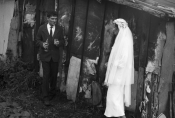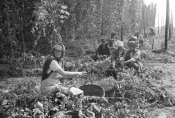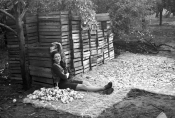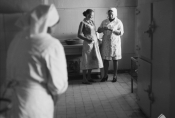WOMAN FROM THE PROVINCES [1984]

year:
- 1984
release date:
- 11 XI 1985
runtime:
- 104 min
directed by:
- Andrzej Barański
written by:
- Andrzej Barański based on the novel by Waldemar Siemiński
director of photography:
- Ryszard Lenczewski
cast:
- Ewa Dałkowska [Andzia Cichalska-Solska], Ryszarda Hanin [Andzia’s mother], Bożena Dykiel [Jadźka], Magdalena Michalak [Celinka], Halina Wyrodek [Andzia’s friend], Hanna Giza [Siejwa, a Jewess], Ewa Zdzieszyńska [Brewka, Andzia’s ward], Hanna Stankówna [a holidaymaker], Katarzyna Rubacha [little Andzia], Kazimierz Wichniarz [Felek Solski], Aleksander Fogiel [Andzia’s father]
edited by:
- Marek Denys
music by:
- Henryk Kuźniak
production design:
- Paweł Mirowski, Adam Kopczyński
produced by:
- Studio Filmowe „Oko”
executive producer:
- Marek Depczyński
awards:
-
• Polish Feature Film Festival Gdańsk 1985: Special Jury Prize, award for music for Henryk Kuźniak, Journalists’ Award, Journalists' Award for Ewa Dałkowska
• Warsaw Mermaid 1985
• International Film Festival Berlin (Germany) 1986: Forum of Young Cinema Award
• Cinema Enthusiasts’ Award: Samovar 1987
About the film
Sixty-year-old Andzia has always lived in a small town. She comes from a poor family and her life is a constant struggle for survival. Andzia’s story is told in reverse chronology. The subsequent episodes establish her character and determine her attitude to the world. Now, she is the wife of a tenement building owner and she no longer suffers from poverty. She married him at the age of fifty, having already raised two children alone.
Andzia lives as if on the surface of events. She is a simple woman and she does not see the banality of her daily existence. In the 1950s, she is a dishwasher in a restaurant. She wants her daughter to get married and she is trying to give her adolescent son enough training for him to get a job. Small savings make her very happy. During the Nazi occupation, she works for the Germans in a soldiers’ kitchen. An important experience for Andzia was the expulsion of Jews from her hometown, when she had to part with her best friend forever. In the mid-1930s, Andzia gets married for the first time. She rejects her true love and is persuaded to marry a man she doesn’t love. Soon, the man drowns in a river. Andzia is a little girl. Brought up in a poor home, she knows that the world will not provide any support for her. She makes money by drying and selling herbs. The film closes with an image of a child making its first steps. It is Andzia.
It is more difficult to describe the human, internal life, to reproduce it in its own light, unique and true, to preserve all the little gestures, the melody of speech, and even individual words that testify to what my characters think, how they react, who they are. I believe that writing people’s stories with such film language, elevates ordinary participants of life to the status of heroes.
Andrzej Barański
Joanna Piątek, Leksykon polskich filmów fabularnych, Warszawa 1996












